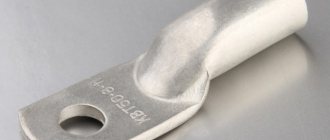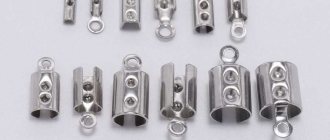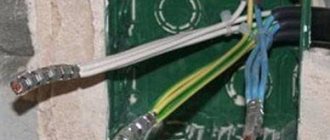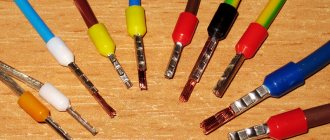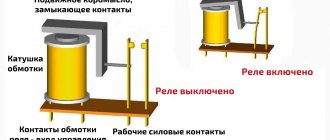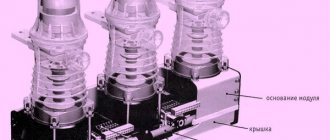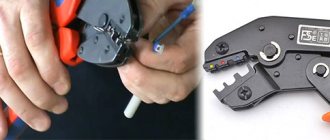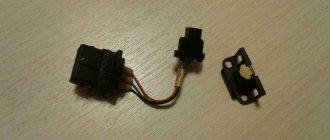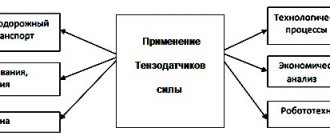- First, choose the right connector or tip so that its size matches the cross-section of the wire being pressed.
- Secondly, use a professional tool. These are press pliers equipped with a ratcheting mechanism that will allow you to perform a full crimping cycle.
- And thirdly, select the desired matrix. Its geometry and shape must correspond to the crimp part of the tip.
Crimping or crimping wires with insulated or non-insulated lugs has become very accessible recently. This process even has a number of advantages over tinning wire cores:
- faster
- more reliable
- cheaper
When the wire is tinned and used for a long time, due to temperature changes, the contact may weaken. This causes the tinned connection to heat up.
And since the melting point of solder is low, it easily burns out or melts under load, weakening and significantly reducing the contact area. Next, sparking occurs with all the current negative consequences.
Where are cable lugs used for crimping?
We can talk endlessly about the areas of application of crimp wire lugs. In order not to overload the reader with unnecessary information, we will consider only the main ones:
- in production. Not a single connection of power lines to each other or to electrical equipment is complete without crimping the cable lugs. This ensures tight contact and, as a result, reliable operation of electrical appliances and equipment. The shape and size of such elements are selected according to the cross-section of the cores and the material of manufacture;
The main advantage of such connections is reliability.
- household sphere. A home craftsman rarely thinks about the benefits of tips, but in vain. If we disassemble any household appliance, we will see that not a single connection is complete without them. In everyday life, elements that differ from industrial ones are used. But they perform the same function: tight contact, no heating and no need for periodic tightening of the terminals.
NShVI pin lugs
NSHVI are pin sleeve lugs for wires for crimping. They are made of electrolytic copper, on the back of which insulation is installed. The material is processed by galvanic tinning. For domestic and industrial purposes, such lugs are used for cables with a cross-section of 0.25 sq. mm. NSHVI has many advantages and one of them is saving time when connecting to electrical devices.
Characteristics of pin lugs
Products come in single and double versions. When used, it only takes a few seconds to install the cable. The pin tip does not require special skills to use. There are NSHVI tips with different sleeve sizes. In this case, color marking is used.
Marking and decoding
The industry produces a large number of all kinds of tips, which differ in design and materials.
Color coding option
There is a special marking system that allows you to distinguish the material and use it for its intended purpose. Here is a breakdown of some of the symbols:
- A – the sleeve is made of aluminum;
- L – brass is used;
- M – the base of the product is copper;
- T – the element is made of tubular metal;
- U – the connector is made in the shape of an angle.
There is also a designation in the form of the letter O, which indicates the presence of an inspection window through which you can make sure that the cables are correctly located in the sleeve inside.
If the marking is TML (O), then it means tinned tubular copper with an inspection window. NSHVI - means a pin sleeve tip, and NKI - a ring one. In this case, the numbers indicate the cross-sectional area or diameters of the rod. To make it easier to find suitable connectors, for example, NShVI or KVT, you can use a special catalog or tables.
After the letter designations in the markings there are usually numbers that contain information about:
- nominal section;
- diameter of the contact rod;
- internal diameter of the shank.
For example, the product is marked TML (O). This means that this wire termination is made of copper tubing and is tinned. Its distinctive feature is the presence of a small hole - an inspection window, with which you can verify whether the wire is inserted correctly for crimping.
Such contacts are used mainly in production, so not all electricians are aware of their existence.
Decoding and purpose of NSHVI
NSHVI is a type of tip, which is deciphered as follows:
- "N" - tip.
- "Ш" - pin.
- "B" - bushing.
- "I" - isolated.
This type of tip is used when crimping copper wires with a large number of cores for subsequent connection to devices and assembly of electrical circuits.
Crimping is carried out using a special tool - NSHVI crimping pliers. In other words, the task of the product is to ensure high-quality contact and integrity of the cores when connected using a screw clamp.
Sleeve NShVI are used for copper wires with a cross-section in the range of 0.5-35 sq. mm. After installation of the product, solid pins are formed at the ends of multi-core cables, simplifying connection to the terminal or equipment.
What does the tip marking mean: full explanation
Each type and type of product has its own alphanumeric marking, without knowing which it is impossible for a home craftsman to explain in the store what he needs. Let's look at popular markings:
- TML is a tin-plated tip, to work with which you need a special tool - a crimper. Looks like NSP. The only difference is that NShP is copper;
- TA – the same tip, but made of aluminum;
- SIP is a self-supporting tip that has its own insulation along the tube and an annular mounting plate;
- NSHVI - common in household use, sleeve pin;
- NKB - used in industry as geophysical cable;
- RFI-M is already a flag tip;
- IEK – copper fork;
- TMD – double blind connectors;
- NKI - isolated ring.
Aluminum products are regulated by GOST-9581-80, copper - GOST-7368-80.
Products for crimping are made of copper, aluminum or bimetal
Execution options
According to their design features, tips can be single or double. The product is a copper tube processed by galvanic method. The tip may be flared at one end. This is necessary when working with stranded wire. The insulating component is a polyamide cuff.
Aluminum products
For your information! Useful elements protect homes from fire or heating of wiring due to poor fixation of wires.
Types of tips by design
Depending on the design of the terminal and the connected electrical appliance, the shape of the tip is selected. It comes in several types.
| Photo | Name |
| Ring | |
| Fork | |
| Power | |
| Tubular or sleeve | |
| With pin | |
| Socket for quick connection of wires |
The lugs can be used to connect one or two wires; for the second case, special parts are produced. Fixation is carried out by crimping or a bolt built into the shank. The first option is most applicable in everyday life and in production; it is intended for flexible wires made of multiple cores. The second is suitable for rigid cables.
Clamping wires of different sections into a common terminal
The most difficult task during installation (especially for novice craftsmen) is combining conductors of different cross-sections in one connector. To avoid problems, you should adhere to the following rules:
- Wires of larger and smaller cross-sections are diverted from each other. This can be done thanks to different insulation of the conductors, as well as a reserve in diameter at the tip skirt. The thinner product is stripped a greater distance, after which it is moved forward so that it ends up in the end first.
- At the second stage, the main wire is inserted into the tip all the way and crimping is performed.
A similar principle should be followed in the case of double NSHVIs - first the thin conductor is inserted, and then the main wires are inserted. For crimping, it is recommended to use STK-03 pliers. While working, make sure that the tool does not snap into place. To do this, hold the ratchet lever while crimping.
How to choose the right tip for crimping
The correct choice of this electrical installation element depends on the material of manufacture, flexibility, cable cross-section, as well as the method of connection to the device or equipment:
- Cable cross-section is an important aspect. If it is larger, the cable simply will not fit into the sleeve, and if it is smaller, the crimp will not be tight, and there is no point in such a tip.
NShVI are usually sold in such sets, but can also be purchased individually - Flexibility of the wire – this can also lead to a loose connection. For example, we use a product with a bolted connection and a flexible electrical cable. When screwed in, the bolts push the wires apart, pressing only a few “hairs” in the middle. There is no talk of any contact anymore.
- The method of connecting to the equipment may also differ. If switching is not possible with a direct connection, it is necessary to use.
Tip material
Another relevant point in choosing a tip is the material of manufacture. When purchasing, make sure that they are selling you copper or tinned tips. To do this, it is enough to first purchase one tip and file it with something foreign.
With copper material, especially if high-quality copper is used, the cut will be reddish in color. If ordinary copper alloys are used, which is most often the case, then the cut will be a pale yellowish color.
When exposed to air, copper may darken and lose contact quality. Copper tinning is a long-known method that makes the contact durable and reliable.
Advantages of crimping wires with lugs
- the crimped end of the wire is considered airtight
- the ferrule sleeve prevents individual wires from being damaged or excluded from contact
- tinned tip surface – reliable protection from environmental influences
Main types of lugs for crimping
Depending on the material from which the tips are made, there are several types of these elements:
- copper – used for cables made of copper conductors;
- tinned copper – tinning treatment provides protection against corrosion;
- aluminum – suitable for aluminum wires;
- aluminum-copper - allow you to connect aluminum and copper wires.
Elements can have different cable connector diameters and bolt mounting holes, different blade sizes and shapes. Some of them are equipped with an inspection window that allows you to adjust the position of the cores inside the part.
Types of tips by material
Copper cable lugs: general information
Copper cable lugs for crimp testing are made from copper pipes of a certain diameter. The pipes are cut and flattened on one side. A hole of a certain diameter for a bolt is made in the flattened part. Produced at special enterprises.
There are two types of copper cable contacts:
- uncoated cable lugs;
- with tinned coating.
Tinned contacts are considered more practical to use. Tinned coating protects the part from corrosion and extends its service life. In addition, tinned contacts are resistant to solutions of nitric, sulfuric and hydrochloric acid.
They are not afraid of exposure to air, moisture and other aggressive environmental factors. Due to the coating, the electrical conductivity of the terminals is reduced. However, it consistently maintains excellent performance.
But uncoated copper contacts will oxidize very quickly. Because of this, the conductivity indicator decreases, the resistance increases, which leads to heating of the connection.
The lugs are used for terminating cables with copper cores. For their installation, special press pliers are usually used, which are used to crimp the end onto the cable.
Copper cable lugs for crimping are used for:
- establishing communication between the power grid and the device;
- establishing contact between devices or a group of devices;
- splicing several electrical wires to increase the length.
Homemade copper
Today there are many cable copper crimp terminations, which, in particular, are very easy to decipher. But there are cases where it is impossible to select a cable lug of the required volume. Then it is possible to use a non-standard option - to create one yourself.
The creation process is simple. To do this, you need to take a copper tube with a certain size. Next, flatten the end and make a hole with the desired diameter.
Homemade copper
NShVI pin lug
NSHVI - insulated pin sleeve end. The sizes of NShVI tips are from 0.25 to 150 mm. Made from tinned electrolytic copper. Designed for household use, suitable for any multi-core wires.
How to crimp NShVI bushings?
Before crimping, the wire is stripped using an insulation stripper, a special knife or a stripper. The first option is the most convenient and allows you to quickly get rid of the top insulation without damaging the cores. Stripping is carried out precisely along the length of the sleeve into which the conductor is installed.
As soon as the preparatory work is completed, a sleeve is put on the insulated part. Pre-select the pin sleeve tip (NSHVI) of the required length.
When crimping, special pliers are used, which were mentioned above. While doing the job, it is important to know how to use press jaws. If the technology is violated, the quality of fixation leaves much to be desired.
To avoid errors, the sequence should be like this:
- Inserting the stripped edge into the sleeve;
- Installing the tip into the tool groove. It is important to ensure that the insulated part is pressed tightly against the body of the pliers;
- Clamping the handle with sufficient force to ensure reliable fixation of the connector.
If you do everything correctly, you get a reliable connection, and the structure itself is monolithic and strong. The principle of crimping using NSHVI-2 is similar. The main thing is to accurately select the cable cross-section. This is not difficult to do. The first numbers show the cross-section, and the subsequent ones (indicated by a hyphen) show the length of the working part.
The optimal tool for crimping in terms of price-quality ratio is considered to be the WS-04A, which was mentioned earlier. Its peculiarity is the presence of lower teeth, which ensure reliable crimping of the product. Thanks to the groove, the connector is tightly compressed and cannot be removed.
When installing the NShVI, keep one nuance in mind - use the section one step lower. What does it mean?
For example, if for a cross-module the permissible cross-section of a stranded wire is specified as 16 sq. mm., after crimping a 16mm analog using NShVI, the structure will not fit into the connector. Here you should use a 10 kV cable. mm.
The PKVK-10 tool is considered no less convenient, but it is used for smaller sections. After crimping, the connector has a rectangular, rather than trapezoidal (as in the previous case) shape.
The advantages of the tool are reliability and ease of use, but even with it there are “punctures” in the form of poor-quality crimping (this nuance should be monitored when performing work).
Sleeves for wires for crimping
Sometimes there is no need to use a ferrule, but crimping the wires with sleeves is required. They can be of two types - GML (tinned copper sleeve) or GAO (copper-plated aluminum sleeve). The choice depends on the cable material.
Good to know! When connecting aluminum wires, it is advisable to use quartz vaseline paste. It prevents the oxidation process from occurring.
Twisted pair cables are crimped in a similar way. The only difference is in the matrices
Basic rules for crimping
To perform high-quality crimping of wires with sleeves or lugs, you must follow the following rules:
- choose the right tip;
- properly and thoroughly strip the core;
- use specialized tools for work;
- select a suitable matrix;
- Follow the crimping sequence.
It is important to correctly set the hole diameter on the tool so as not to damage the connected elements.
In the table you can see some tips for crimping
You can watch the features of crimping in this video:
Why crimping?
Soldering a stranded wire is not the easiest operation, because you need to expose all the wires, make sure that they are clean in terms of contact, and only then start soldering. Any core in a stranded wire has insulation, and this often creates difficulties in establishing reliable contact.
Just crimping the cable lugs solves all these problems, because with the help of mechanical force (compression) not only the insulation of individual cores is destroyed, but also a strong connection of the entire cable is created for better contact.
This is where the moment arises of how to choose the correct sleeves for crimping wires, because they are made from different materials and have very precisely specified current characteristics.
The problem is that the size of these cartridges is small, and the markings are unclear to those who are not specialists. But before that, let's define the difference between a sleeve and a cable crimp lug.
Another point that is not even in the markings is the moment of tightening the sleeve or tip during crimping. And they are completely different for different types of tips, such as:
- ring (NKI).
- fork (NVI).
- pin round (NSHKI).
- flat (plug) connectors (RPI-P, RPI-M, RSHI-P, RSHI-M, etc.).
- piercing type couplers (OV).
Here it is necessary to return to the tool that is used to crimp the wires, because on each tool the dimensions are indicated for the standard shape of the jaws, and the force itself is accurately measured by diameters. So, unless you made a mistake with the diameter, you cannot apply excessive force.
And, despite the fact that the lugs for wires for crimping are different, with the same diameter both the force and the standard of the tool will be the same. It's a pity that this parameter is not reflected on the labeling. Apparently because such work is usually done by professionals, not home electricians.
But it is precisely the standards that allow home electricians to stock up on universal crimping pliers and crimp cable lugs for their own purposes without any problems. This procedure is quite simple to master, and technologically it is the same for crimping an RG-45 connector and a tip for a three-phase machine.
When crimping a multi-core cable, you cannot do without special lubricants. Therefore, use sleeves and tips that already have this lubricant inside. In any case, this is a one-time operation. It is not possible to remove a part to move it to another location.
As a result, having mastered the installation of sleeves and tips, you will be able to quickly restore the desired connection, carry out repairs without problems, as well as a connection that, in fact, will not need repair for many years.
Purpose
Cable lugs are designed to create reliable contact between multiple conductors, a wire and a busbar, or a wire and a terminal. Electrical contact in this case can be ensured by tightly fitting the walls of the cable lug along the diameter of the core, using solder or clamping with a screw device. They are also designed to simplify installation processes in electrical installations, perform any technological operations, etc.
Cable lugs are designed to replace all kinds of twists and other types of homemade connections common among would-be electricians. This device ensures optimal fixation of the wire inside the sleeve and reliable contact.
Preparation for crimping
To crimp using a cable lug, you need to prepare the wire. See the table below for how to do this.
| Photo | Action |
| Measure the depth of the shank, add 5 mm and make a mark on the cable | |
| Clean the conductors from the insulating layer, check that the edge is smooth | |
| Degrease the wire and put a tip on it, the wires should fit tightly inside the shank |
Procedure for crimping cable lugs and sleeves
For crimping thick-walled tips and sleeves, it is best to use a hydraulic press. The press set initially includes universal dies for any tips and wires.
Under no circumstances use a tool not intended for crimping (hammer, chisel, etc.). A contact pressed in this way will not last long, especially if it constantly experiences heavy loads.
The next question that arises for an ignorant user is: how many times should I press the tip with a press? Once, twice or three times?
This depends on 2 parameters - the length of the tip and the width of the matrix.
In the operating instructions for the press that comes with the tool, there is a sign indicating the required number of crimps. Please note that this table is intended for tips and sleeves made in accordance with GOST.
Insert the tip into the press so that the matrix cross-section markings (35-50-70, etc.) are imprinted on the front side of the tip, and not on the side or bottom.
- do the first crimp test closer to the blade (where the bolt is inserted);
- Perform the following crimps in order, moving from the blade to the tail of the tip.
The same rules apply for connecting sleeves.
This must be done in this sequence, because with each press the tip tends to lengthen (sometimes up to ten percent!).
And if you start pressing from the end (not from the blade), during the last crimp, there is a high probability that you will have a void at the end of the sleeve. And you will not achieve the contact that was necessary. First of all, this applies to all aluminum products. For copper this is not yet so critical.
Popular products in Russia
There are many factories in Russia that produce NShVI tips. The leading position in this market segment is occupied by the KVT plant, which produces electrical installation tools and cable fittings of high quality and affordable prices.
Today, the plant’s product range includes more than four thousand items, which allows you to select the appropriate tools and components.
The plant produces the following products:
- Cable lugs and sleeves designed for crimping wires and cables.
- Bolted lugs and connectors - for convenient installation of cable cores. The peculiarity lies in the versatility and reliability of contact, which allows the product to be used as components for heat-shrinkable cable sleeves.
- Insulated tips, sleeves and connectors.
- Insulated clamps and terminals.
- Cable couplings KVT.
- Elements of cable couplings and other elements of equipment designed to work with wiring.
Ferrule crimping
To find out which tool is best to use for crimping various types of tips, watch this video:
As you can see, you don’t need any special intelligence or experience to use the tips; everything is done easily and quickly. The only thing you will need are special devices - a stripper and press pliers, but they are affordable and can be purchased. When connecting multi-core conductors, be sure to use lugs and make the power supply as reliable and safe as possible.
How to crimp a wire: instructions for single and double NShVI
The wire with the tip must be installed in press jaws in a matrix of a suitable size. During the crimping process, you need to ensure that the wire does not move inside the sleeve. The first crimp is done with an indentation of 1–2 mm from the edge, if necessary, the second at the same distance from the first.
The handle of the press pliers is compressed until it is in full contact with the surface of the part and the matrix is connected, then the sleeve is moved and a second crimping is done. If the shank is long, work continues until the colored skirt.
The crimping scheme for a double tip is practically the same. You only need to insert two wires into one hole in the shank at the same time.
Stages of wire crimping
Visual instructions for crimping a wire with an NShVI lug are presented in the video:
Crimping power cable lugs
When crimping power cables, tinned copper lugs are used, which are well protected from corrosion. If, when cutting the cable, its cores “fluff” significantly and become larger in diameter than the rest, then perform the work on a sharpener. When unrolling the cable, make sure that the circle removes excess knots along the cores and does not bend them.
Soldering is absolutely not suitable for crimping a power cable, since single tin contacts cannot be used on such wires.
Which tip to choose
Before you begin crimping, you must select the correct tip. It is worth remembering that such products come in different types - different sleeve thicknesses, different inlet diameters. Moreover, this happens with connecting parts of the same cross-section, but from different manufacturers. Therefore, it is not always possible to crimp 2 different lugs for wires of the same cross-section using the same matrix. In addition, the number of sleeve crimps may also differ.
If you want to achieve a high-quality connection that will reliably serve you for years, use the following recommendations.
- The core, stripped of insulation, must clearly correspond to the diameter of the tail part of the tip.
- There may be play, and it is acceptable, but it should be minimal.
- If the tip material is aluminum, then the choice is simpler. Select a tip of the same cross-section as the cross-section of the wire. You can navigate by the inscriptions on the blade of the contact part.
But if the material of the product is copper, then certain difficulties arise. But there are several solutions here too.
- There are GOST tables that can be used to select the desired type. But this is not entirely convenient, because... you need to clearly know and distinguish between core flexibility classes, and you don’t always have these tables at hand.
- measure the diameter of the cable core with an ordinary caliper. Then compare it with the diameter of the inner part of the tip shank, which can be determined using the same caliper, or by the inscription on the blade.
The third group of numbers in the marking TM-35-8-9 will be exactly the required diameter. That is, if the diameter of the core that you measured turned out to be 8.5 mm, then the most suitable option would be the tip marked TM-35-8-9.
Please note that the diameter of the core should be slightly smaller, but not larger than the diameter of the shank.
The material of manufacture of the tip and sleeves must be the same as the material of the wire or cable core. Connect aluminum wires with aluminum parts, copper with copper. Otherwise, corrosion processes cannot be avoided.
If you need to connect an aluminum terminal to a copper contact (on a switch or switch), use an aluminum-copper ferrule or use aluminum-copper washers.
There are special aluminum-copper sleeves for joining copper and aluminum cable cores.
Why can't you twist the wires?
The wires inside the bushing are crimped under very high pressure, so that they can even change their original circular shape if they lie parallel to each other. From a circle they turn into a hexagon, and this increases the area of their contact surface with each other.
And when you twist them, during crimping, in those places where the veins intersect, they can be pressed against each other.
Popular crimping tool
To install KVT tips, use the following tool:
- WS-04A is the optimal pliers for beginners. With their help, it is possible to solve the main set of problems in the process of installing various electrical circuits and assembling panels. Its functions include the ability to bite off and strip wires (cables) with a cross-section of up to 10-16 square meters. mm. In addition, it provides recesses for NShVI tips up to 6 sq. mm. (if desired, a cable up to 10 “square” is included) or up to 10 sq. mm. (includes up to 16 “square”). On sale you can find WS-04A pliers, which are equipped with dies for crimping NShVI. Their disadvantage is that the matrices can only cope with products of standard sizes up to 6 square. If you use wires with a reduced cross-section (fake), the quality of the connection will be poor.
- PKVk-10 is a universal tool that is used for crimping conductors of 0.5-10 sq. mm. But this is in theory, because in practice the situation is different. For example, to crimp a cable from 6 "square" and above, a lot of force will be required, and if you reduce the crimping force, the quality of contact when crimping connectors with a small cross-section deteriorates. The advantage of PKVk-10 is its compactness and the ability to get into even hard-to-reach places for installation (if necessary). The tool is best used for crimping conductors up to 4 square.
- STK-03 - powerful pliers that are suitable for large sections (from 10 to 25 “square”).
- PC-16. These pliers are useful for crimping TML from 6 to 10 sq. mm. The manufacturer sets the upper limit at 16 sq. mm., but in practice, crimping such a cable requires a strong hand and a lot of effort. Overall, the tool is not very good, but it has an affordable price. The PK-16u version is available for sale - a reinforced version that is more durable. The tool is suitable for cases where crimping is rarely carried out.
- PGRs-70 is a hydraulic press that is used for TML and sleeves. Many consider the tool as an alternative to PC-16. A special feature of the press is the availability of interchangeable dies with different cross-sections in the range of 4-70 sq. mm. With the help of such equipment it is convenient to crimp classic cables - six, ten or sixteen square millimeters. It does not require a lot of load or excessive effort.
- PKVsh-6 - used for crimping NShVI and NShV from 0.25 to 6 sq. mm., as well as a double tip NSHVI-2 with a cross-section from 0.5 to 4.0 sq. mm.
As for Wiedmuller or Knipex pliers, their disadvantage is the large divergence of the handles. As a result, it is difficult to crimp the NShVI with one hand (the fingers are not long enough).
To avoid discomfort when performing work, you should select a tool based on ease of use, and not focus on the brand.
Required Tools
Crimping is carried out with a special tool that allows you to create the necessary force. The following tools are popular:
- Press pliers for crimping PK2 and PK2M lugs are used for terminating cores with a cross-section of up to 10 sq. mm;
- PK1 and PK1M brand tools are a more powerful version of hand pliers;
- hydraulic pliers allow you to crimp wires up to 10 sq. mm;
- In industrial production, a hand press is used. It is suitable for wires up to 240 sq. mm;
- hydraulic press with electric drive is used for cables up to 300 sq. mm.
Types of instruments
Press pliers with hinges increase the pressure of the tool, which makes the manual crimping process easier. Devices with a ratcheting mechanism are especially convenient. They prevent the instrument from unclenching until the procedure is completed.
You can watch how to crimp a wire without tools in this video:
Types of press jaws
The manual crimper is used for crimping non-insulated cable lugs, contact connectors, terminals and contact sleeves of various sizes. If a manual crimper has special blades (usually they are located where the handles are attached), then this tool can also be used for cutting cables and wires.
Electric pliers are a multifunctional tool for professional use. They can do almost any work with wires. Electric pliers are mainly used for cutting and stripping wires, but they can also be used to crimp uninsulated and insulated cable ends.
A crimper is a tool for crimping wire lugs, twisted pair cables, and connectors. It has two long handles (one or both can be movable) and a massive working part in the form of metal jaws, which have holes for cables.
When the handles are brought together, the jaws close and the cable connector is crimped using forceful pressing. Some models have a blade on the working part, which simplifies the work - no additional tools are required to cut the cable.
How to choose press jaws
The choice of crimping tool is determined by the cross-section of the wire. The larger it is, the more powerful the device should be. Human effort is not enough to create a tight and uniform pressure, even when using household tips.
Crimping of cable lugs is performed using one of the following tools:
- Press pliers of brands PK2 or PK2M - for manual use, suitable for wires with a cross-section of up to 10 sq. mm.
- Hydraulic pliers – designed for terminating cables up to 10 sq. mm.
- Press pliers for crimping terminals, brands PK1 or PK1M - similar to the first tool, but reinforced with long handles, due to this they are capable of crimping a wire up to 50 sq. mm.
More powerful devices, such as manual and hydraulic presses, are used in production. With their help, you can crimp wires with a cross-section of up to 30 sq. mm.
Hand press pliers for home use
What is termination
Wire termination is one of the simplest and most reliable ways to connect wires to terminal blocks, circuit breakers and other electrical equipment. This type of connection is common in household and industrial networks. This is due to the advantages that termination allows to achieve:
- reliable contact patch;
- ease of installation;
- low connection resistance;
- general aesthetics of the wiring.
The main advantage of terminating cable cores is the low contact resistance of the resulting contact. If it is not used, the wire will not be able to properly press the screw onto the terminal block bus. This will cause the contact resistance to be too high. A bad connection will start to heat up or completely burn out.
Termination is done using tips. Externally, they resemble copper or aluminum caps. On one side, a wire pre-stripped of insulation is inserted into them, and on the other there is a hole for fastening with a screw. The tip serves as a reliable adapter between the cable and the device to which it is connected.
Stranded wire crimping
How to crimp wire lugs without tools
What to do if you don’t have special tools for crimping on hand or you just don’t want to buy them if you only need to crimp one or two tips?
Many, faced with this problem, resort to incorrect methods, which in the future only worsen the contact, without ensuring a reliable connection. They begin to flatten the tip with hammers, simply squeeze it in a bench vice, crush it with pliers, and press it in with a chisel. All these methods are incorrect and do not bring the desired result. After such amateur activity, poor contact is obtained with its further heating during operation.
How to terminate a wire without a ferrule
Using lugs is a convenient way to terminate wires. However, they are not always at hand. In this case, the cable is terminated without lugs. The current-carrying conductor, stripped of insulation and dirt, is manually bent into the shape of a ring (ear) under the bolt. To form the joint, use long-nose pliers with a rounded outside. The resulting connection is less reliable than the factory-made tip.
If the wire is copper, then the eye for the bolt can be tinned with solder. It is necessary to bend the ring in the direction of tightening the screw, so that during the tightening process the eyelet twists around the bolt, and not vice versa.
Additional Information. Modern aluminum wire is not flexible. Its strands are more fragile than those of copper cable. This should be remembered when terminating and forming connecting rings. Aluminum wire must be bent a minimum number of times.
Where to buy cable lugs for crimping
Before you go to the store, you should familiarize yourself with the options offered on the market in advance. The table shows prices for some cable lugs for crimping.
Photo Products Characteristics Average price, rub.
| Tinned copper tip GPH (w = 29 mm) 120 mm.sq.*M 16 | The flange shape is ring. Material copper. | 320 | |
| Tinned copper tip GPH (w = 29 mm) | |||
| Sealed insulated tips NIM 25 (CPTAU 25) IEK | Combined material - copper and aluminum. Cross section 25 sq. mm. Longitudinal sealing available | 268 | |
| Sealed insulated tips NIM 25 (CPTAU 25) IEK | |||
| Tinned copper tip TML 2.5mm.sq. x M5 (W=10mm) | Material copper. Cross section 2.5 sq. mm. Ring flange shape. | 433 | |
| Tinned copper tip TML 2.5mm.sq. x M5 (W=10mm) | |||
| Navigator NShvi 10-12 NET-E10-12 isolated 4670004710920 155767 | Material tinned copper. Polyamide insulation. | 536 | |
| Navigator NShvi 10-12 NET-E10-12 isolated 4670004710920 155767 | |||
| Pin sleeve insulated tip NSHVI2 2.5-10, 50 pcs Peredovik 26685 | PVC insulation. Material tinned brass. Wire cross-section 2.5 sq. mm. | 87 | |
| Pin sleeve insulated tip NSHVI2 2.5-10, 50 pcs Peredovik 26685 | |||
Pin sleeve insulated tip NSHVI2 2.5-10, 50 pcs Peredovik 26685
To choose a quality product, remember that each tip must have a specific wire. The discrepancy between these two elements most often leads to errors when performing crimping. You cannot use homemade tips or cut the sleeve into two parts to save money. We hope that our advice will be useful to you and help you make the right choice.
Working methods
When using NShVI tips, it is worth considering the following:
"SKIRT" COLOR. The product shows the cross-section of the connector. As a rule, we use the KVT standard, which is characterized by the following:
- Black - 1.5 sq. mm;
- Blue - 2.5 sq. mm;
- Gray - 4 sq. mm;
- Yellow - 6 sq. mm;
- Red - 10 sq. mm.
It is worth noting that goods from stores deviate from the standard. At the same time, the size of the product and color do not correspond to KVT in any way. The downside is low quality and rapid destruction. That is why, when choosing, you should pay attention to the color of the “skirt” and its correspondence to the cross-section.
PACKAGE. As a rule, NShVIs for crimping come in packs of one hundred products, which are packed in groups of five in a larger package. It is not possible to purchase such a product individually.
If you need to connect two cables, there is no need to “reinvent the wheel.” NShVI-2 connectors of the same type of installation are available for sale. For example, if you buy a product for four square meters. mm, it easily accepts two wires per 4 sq. mm.
Design and types
The product consists of 2 elements:
- CURRENT CONDUCTING TUBE. In the process of its manufacture, electrolytic copper with mandatory tinning is used.
- POLYAMIDE FLANGE, INSULATED.
In simple terms, NSHVI cable lugs are copper tubes processed by galvanization and having one flared end (for inserting a stranded conductor). The second part of the product is a polyamide cuff, which provides reliable insulation and protection against voltage.
During the manufacturing process, a special type of copper is used, which ensures a reliable connection at the contact point and avoids damage to the conductor due to screw pressure. Today you can buy an NShVI tip with a cross section of 0.25-150 mm.
According to the design of the device, there are two types:
- Single.
- Double.
The first are intended for crimping one, and the second - two stranded wires at the same time. This is their main advantage. For example, when power is supplied to the AB (circuit breaker), it is possible to eliminate an additional wire jumper from the circuit. Based on the characteristics of each type, the size of the plastic flange varies.
In addition to the type of product already discussed, there are other types:
- TML TIPS - used for crimping copper and aluminum cables by crimping for subsequent connection to a bus or equipment. There are two types of TMLs - copper and aluminum. The former are used to connect cables made of copper, and the latter - made of aluminum. Tinned TML products are used simultaneously with copper and aluminum conductors for crimping and soldering.
- TIPS NVI AND NKI - suitable for terminating flexible (stranded) copper conductors. Used when assembling electrical circuits when screw fixation is used during the connection process. Ring lugs are typically used to provide permanent connections to electrical equipment. If in the future it is necessary to disassemble the circuit and re-cross the clamps, it is worth using NShVI. Thanks to its use, there is no need to dismantle the fastening - just loosen the clamping screw.
Rules for crimping: how to do it efficiently?
To get the maximum effect from using lugs, you need to crimp them correctly and thoroughly prepare the wire.
First you need to expose the veins. Ideally, this is done with a special tool - a stripper. If it is not there, then you can use improvised tools, but try to make the line as even as possible, because the quality of the insulation depends on this. The protective coating is removed 5 mm longer than the length of the shank, since during the crimping process the latter will increase in size.
Stripped copper cable
To protect against corrosion and improve contact, the exposed wire is degreased with special contact pastes.
All wires on the cut must have the same length; if this rule is neglected, the connection will not be of high quality. Some wires can break and become damaged. For the same reason, you cannot twist the wires for termination with lugs, since during the crimping process they will be crushed and will not be able to perform their functions.
Pressure testing is performed in stages. Depending on the length of the tip, 1÷2 crimps with a press may be required. For sleeves – 2÷4 pcs. They are made at a distance of 1÷2 mm. The first crimp should be at the blade, then closer to the edge of the shank.
It is necessary to select a suitable press matrix. If it is less than necessary, then large “ears” of metal will form along the edge of the crimp. After cutting them off, through holes are obtained that violate the insulation.
The tip is installed in the device so that the marking is imprinted on the front side of the element, and not on the side.
Only a small flash is allowed; here, after removing the “ears”, the insulation will be compromised
Video: crimping/crimping wires with various lugs and electrical installation tools
Save time: selected articles delivered to your inbox every week
Choosing the right tip allows you to save money!
Choosing the right tip allows you to save money! The table below will help you choose the size of the tip based on the cross-section of the wire. For example, when terminating a copper wire PV-1 at 95 mm 2, you need to install a T 70-10-13 tip.
| type of copper tip according to GOST 7386-80 | wire cross section | core class | type of aluminum tip according to GOST 9581-80 | wire cross section | core class |
| 2,5-(3,4,5,6)-2,6 | 2,5 | 3;4;5;6 | 16-(6,8)-5,4 | 16 | 1;2 |
| 4 | 1;2;3;4 | 25-8-7,0 | 16 | 3 | |
| 4-(4,5,6)-3 | 4 | 5 | 25 | 1;2 | |
| 6 | 1 | 35-10-8 | 25 | 3 | |
| 6-(4,5,6)-4 | 4 | 6 | 35 | 1;2 | |
| 6 | 2;3;4;5 | 50-10-9 | 35 | 3 | |
| 10 | 1 | 50 | 1 | ||
| 10-(5,6,8)-5 | 10 | 2;3;4 | 70-10-11 | 50 | 2 |
| 16 | 1 | 70 | 1;2 | ||
| 16-(6,8)-6 | 10 | 5;6 | 70-10-12 | 50 | 3 |
| 16 | 2;3 | 95 | 1 | ||
| 25 | 1 | 95-12-13 | 70 | 3 | |
| 25-(6,8)-7 | 16 | 4;5;6 | 95 | 2 | |
| 25 | 2 | 120-(12,16)-14 | 120 | 1 | |
| 35 | 1 | 150-(12,16)-16 | 95 | 3 | |
| 25-(6,8,10)-8 | 25 | 3;4;5;6 | 120 | 2 | |
| 35 | 2 | 185 | 1 | ||
| 35-(8,10)-9 | 35 | 3;4 | 150-(12,16)-17 | 120 | 4 |
| 50 | 1 | 150 | 1;2 | ||
| 35-(8,10,12)-10 | 35 | 5;6 | 185-(16,20)-18 | 185 | 2 |
| 50 | 2 | 185-(16,20)-19 | 150 | 3 | |
| 50-(8,10,12)-11 | 50 | 3;4 | 240-20-20 | 240 | 1 |
| 70 | 1;2 | 240-20-22 | 240 | 2 | |
| 50-(8,10,12)-12 | 50 | 5;6 | 300-20-24 | 185 | 3 |
| 70-(10,12)-13 | 70 | 3;4;5;6 | 240 | 3 | |
| 95 | 1 | 300 | 1;2 | ||
| 95-(10,12)-15 | 70 | 5 |
Conductor classes: 1 - single-core conductor (PV1 wire, AVVG, VVG cable) for stationary installation. 2 - multi-core conductor (wire PV2, cable AVVG, VVG) for stationary installation. 3 - stranded conductor (wire PV3, cable KGL). 4 - flexible stranded conductor (wire PV4, cable KG). 5 - flexible thin-wire conductor (PVS wire, KG cable). 6 - especially flexible thin-wire conductor (KOG cable).
